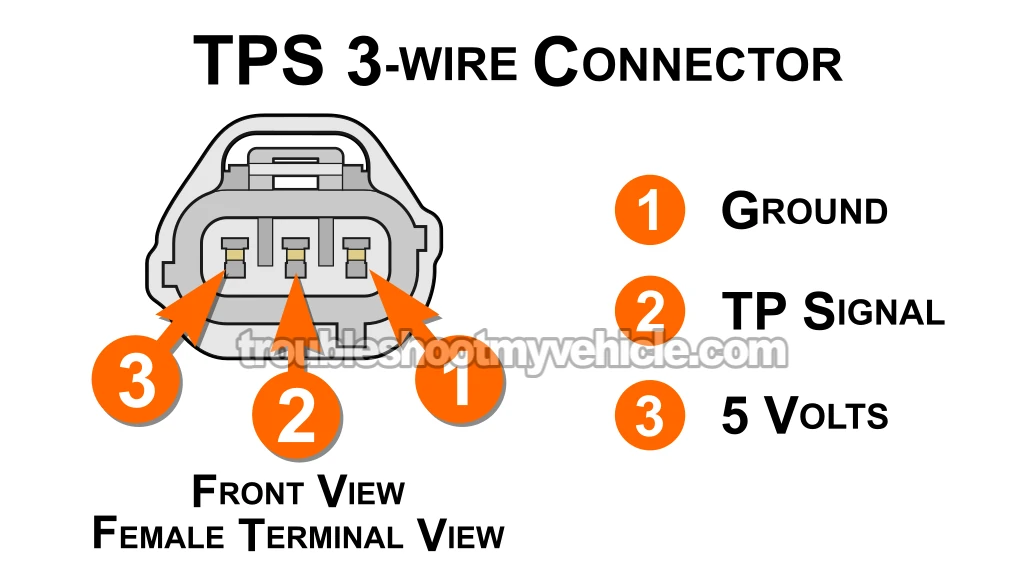TEST 2: Making Sure The TPS Is Receiving 5 Volts

If the TPS signal voltage doesn't move when you open and close the throttle, chances are it's not receiving power.
In this second test, we're going to check if the purple white stripe (PPL/WHT) wire is delivering between 4.5 and 5 Volts of DC power.
In the earlier diagram of the TPS connector, terminal 3 is the one wired to the PPL/WHT circuit.
To verify this wire is supplying the correct voltage, we'll run a quick check using a multimeter.
Let's dive into the steps:
- 1
Unplug the TPS from its connector.
- 2
Switch your multimeter to DC Volts mode.
- 3
Connect the black (negative) lead of your multimeter to the battery's negative terminal.
- 4
Turn the ignition key to the ON position, but do not start the engine.
- 5
Carefully probe the female terminal labeled number 3 on the TPS connector using the red (positive) lead of your multimeter.
NOTE: Double-check that the PPL/WHT wire is indeed connected to terminal 3. - 6
You should get a voltage reading between 4.5 and 5 Volts DC on your meter.
Now let's go over what your results tell us:
CASE 1: You see a voltage between 4.5 and 5 Volts. Perfect! That confirms the TPS is receiving the power it needs —just what we wanted to see.
Next, we'll move on to check for a proper Ground connection. Continue to: TEST 3: Making Sure The TPS Is Receiving Ground.
CASE 2: You're NOT seeing any voltage in that range. If there's no power reaching the TPS, it simply won't be able to generate a signal.
So what could be causing this missing voltage? Here are the most likely culprits:
- There might be a break or open-circuit in the PPL/WHT wire between the TPS connector and the engine computer.
- In rare situations, the issue may lie within the engine computer itself due to an internal fault.
This particular tutorial doesn't go into diagnosing those wiring or ECU issues. But at this point, you've confirmed the TPS itself isn't the problem —it's just not getting the voltage it needs. Your next step is tracking down where that power is being lost.
TEST 3: Making Sure The TPS Is Receiving Ground

So far, the previous tests have confirmed the following:
- The TPS voltage signal didn't change as you opened and closed the throttle plate (TEST 1).
- The sensor is receiving power (TEST 2).
Now, in this final test, we'll verify that the black with light blue stripe (BLK/LT BLU) wire is supplying a proper Ground to the TPS.
As shown in the diagram above, terminal 1 is where the BLK/LT BLU wire is connected.
We'll run a quick multimeter voltage check to see if this wire is supplying Ground from the FI computer to the sensor.
IMPORTANT: This Ground is supplied by the engine's fuel injection computer. Never connect this wire directly to the battery's 12-volt supply —doing so damage the computer! The test method below safely checks for Ground using a multimeter.
Follow these steps to test for Ground:
- 1
Unplug the TPS from its connector.
- 2
Set your multimeter to DC Volts mode.
- 3
Attach the red lead of your multimeter to the battery's positive (+) terminal.
- 4
Turn the ignition key to the ON position, but don't start the vehicle.
- 5
Use the black lead to probe terminal 1 on the TPS connector.
NOTE: Be sure that terminal 1 is connected to the BLK/LT BLU wire. - 6
Your multimeter should display between 10 and 12 Volts DC.
Now, let's break down what your results mean:
CASE 1: You're seeing a reading between 10 and 12 Volts. That's exactly what we're looking for!
If all of the following are true:
- The TPS voltage doesn't change with throttle movement (TEST 1),
- The sensor is receiving 4.5–5 Volts of power (TEST 2), and
- You've confirmed a proper Ground connection (this test),
Then the TPS itself is faulty and should be replaced.
CASE 2: You didn't get 10–12 Volts on your multimeter. This means the sensor isn't Grounded properly, so it can't produce a working voltage signal.
What could be causing the lack of Ground? These are the usual suspects:
- An open or broken connection in the BLK/LT BLU wire between the TPS connector and the engine control module.
- Less commonly, the engine computer might be malfunctioning internally.
This tutorial doesn't go into the steps for tracing those issues —but at this point, you've ruled out the TPS itself as the problem. Now your focus should be on figuring out why Ground isn't making it to the sensor.
More 5.2L, 5.9L V8 Dodge Ram Van Tutorials
You can find a complete list of V8 Dodge Ram van tutorials in this index:
Here's a sample of the tutorials you'll find in the index:
- How To Test The MAP Sensor (1998-2003 5.2L, 5.9L V8 Dodge Ram Van).
- How To Test The Intake Air Temp (IAT) Sensor (1998-2003 5.2L, 5.9L V8 Dodge Ram Van).
- How To Test Engine Compression (1989-2003 5.2L, 5.9L V8 Dodge Ram Van).
- How To Test For A Blown Head Gasket (1989-2003 5.2L, 5.9L V8 Dodge Ram Van).

If this info saved the day, buy me a beer!

